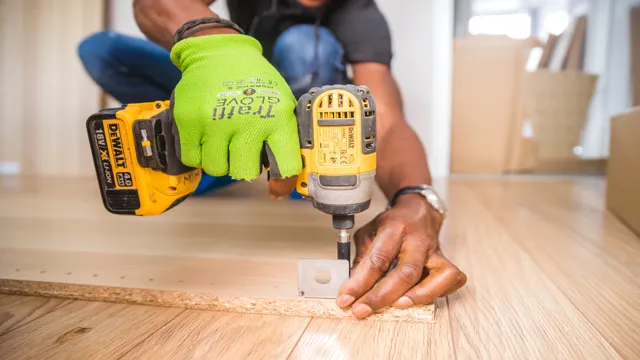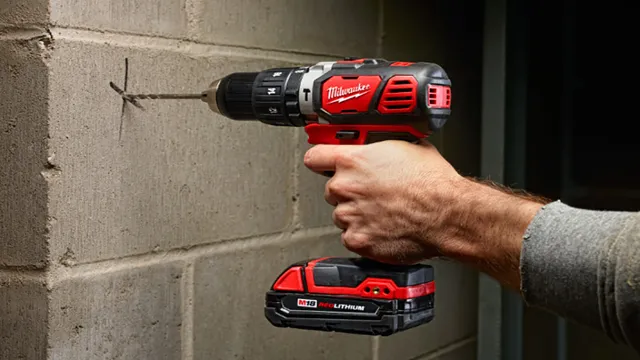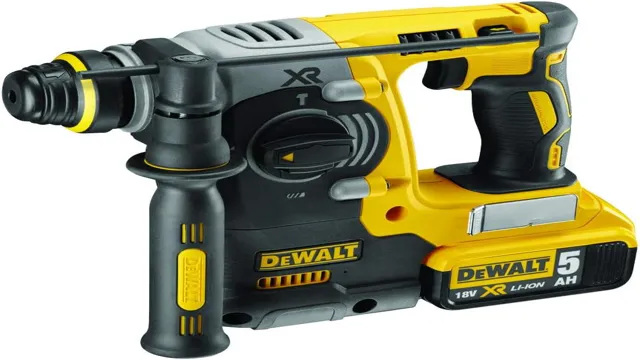How to Use Cordless Drill for Sand Drywall: Tips and Techniques for Smooth Finish

Sanding drywall is a task that nobody looks forward to. It’s a messy and time-consuming job, and if you’ve ever tried doing it by hand, you know it’s not a fun experience. However, what if you could speed up the process and make it less messy? Enter the cordless drill – a tool that can make sanding drywall a breeze.
Yes, you read that right – you can use your cordless drill to sand drywall! If you’re like most people, you probably associate cordless drills with drilling holes and driving screws, but they can be used for a lot more than that. With the right attachment, you can turn your drill into a powerful sander that can make quick work of sanding drywall. Using a cordless drill to sand drywall is not only faster than doing it by hand, but it’s less tiring too.
You might be wondering how it works. Well, it’s pretty simple. All you need is a sanding attachment that can be attached to your cordless drill.
These attachments come in different shapes and sizes, so you’ll need to choose the right one for your job. Once you have the attachment in place, you can start sanding away. Using a cordless drill to sand drywall is perfect for those hard-to-reach areas, such as corners and edges.
It’s also a great option if you have a lot of sanding to do, as it can save you a lot of time. Plus, it’s less likely to cause dust and debris to fly everywhere, thanks to the vacuum attachment that comes with some sanding attachments. So, if you’re planning on sanding drywall in the near future, consider using your cordless drill.
It’s a tool that you probably already have in your toolbox, and it can make the job a lot easier and quicker. With the right attachment, you’ll be able to get that smooth finish that you’re after in no time at all.
Preparing Your Drill
If you’re wondering how to use a cordless drill for sanding drywall, you first need to prepare your drill. Make sure you have the appropriate sanding attachment for your drill. This can be a sanding pad or paper, depending on your specific project needs.
Next, choose the appropriate grit of sandpaper for your project. You’ll want a rougher grit for rougher surfaces, and a finer grit for smoother surfaces. It’s also important to ensure that your drill is fully charged before beginning your project.
Finally, make sure you have all necessary safety equipment, such as safety goggles and a dust mask, to protect yourself from any debris or dust that may be created during the sanding process. By taking these precautions and preparing your drill properly, you’ll be well on your way to successfully sanding drywall with your cordless drill.
Step 1: Choose the Right Sanding Attachment
When it comes to sanding with a drill, the first step is to choose the right sanding attachment. There are several types of attachments available, such as sanding pads, sanding discs, and sanding drums. These attachments come in various sizes and grits, with each one serving a particular purpose.
Before selecting an attachment, it’s essential to prepare your drill correctly. You want to make sure it’s clean and free of any debris that may interfere with the attachment. Additionally, it’s wise to ensure that your drill’s motor is in good condition and can handle the attachment you plan to use.
Once you’ve prepared your drill, you can move on to selecting the proper sanding attachment for your project. By doing so, you’ll achieve a smooth finish and save yourself time and money. Remember, selecting the right attachment is key to a successful sanding project.

Step 2: Install the Sanding Attachment
Once you’ve got a compatible drill, it’s time to prepare it for sanding. First things first, ensure that your drill is turned off and unplugged. You don’t want to accidentally switch it on while you’re attaching the sanding accessory, as that could be dangerous.
Now, locate the chuck key and loosen the jaws of your drill chuck. This will make it easier to attach the sanding disc. Slide the disc onto the drill and align it with the protruding spindle.
Make sure it sits snugly against the drill as you tighten the chuck jaws. Once everything is secure, you can test the grip by giving it a gentle tug. The last thing you want is for the sanding attachment to fly off while you’re working! With the sanding attachment firmly in place, you’re ready to move on to the next step.
You May Also Love:
Step 3: Adjust the Speed
Adjusting the speed of your drill is a crucial step in preparing it for use. First, it’s important to ensure that your drill is properly secured in place, either by using a vice or clamps, to prevent the drill from moving during use. Once that’s taken care of, you can adjust the speed of the drill.
This can usually be done by using the speed control switch found near the trigger or handle of the drill. The key here is to start with a low speed and gradually increase it until you find the optimal speed for the task at hand. By going slowly at first, you’ll reduce the risk of damaging your materials or causing unnecessary wear and tear on your drill.
It’s important to note that different types of materials require different speeds, so it’s important to choose the appropriate speed for the job. Using the right speed will not only ensure optimal performance, but it will also extend the life of your drill.
Sanding the Drywall
If you’re looking for a quick and efficient way to sand your drywall, using a cordless drill might be the way to go. Not only does it save you time and energy, but it also provides a smoother finish. To do this, you’ll need a sanding attachment that can fit onto your drill.
Once attached, start sanding in circular motions, applying light pressure as you go. Be sure to wear a dust mask and protective eyewear to avoid inhaling any dust particles. You’ll also want to periodically check on your progress to make sure you’re not over-sanding in one area.
With a little practice, using a cordless drill for sanding drywall can become a quick and easy part of your DIY routine.
Step 1: Start Slowly
When sanding drywall, it’s essential to start slowly to ensure the best possible result. Before getting started, be sure to prepare the work area by removing any furniture, covering floors, and wearing protective gear. When sanding, gently move the sandpaper back and forth, using light pressure.
It’s important to avoid applying too much pressure as this can damage the drywall and lead to uneven surfaces. As you sand, inspect the surface frequently to identify any bumps or lumps that need to be smoothed out. Remember, the more time you spend sanding, the smoother and more even the final result will be.
Don’t rush the process and take your time to achieve a professional finish. By following these tips and starting slowly, you’ll be able to achieve a beautiful result that’s ready for painting or wallpapering.
Step 2: Move the Drill in a Circular Motion
When it comes to sanding drywall, there are a few steps you need to follow to get the best results. After attaching a sanding pad to your drill, you want to move on to the next step: moving the drill in a circular motion. This is a crucial step because it’s the movement that actually sands down the drywall.
Make sure you’re holding the drill steady and moving it in a consistent pattern. This will help ensure that you get an even finish on all parts of the drywall. You’ll want to start in one corner and work your way around the room.
Remember to take your time and be patient. It’s better to take your time and get a good result than rush through it and end up with a sub-par finish. With these tips in mind, your drywall sanding project should be a success.
Step 3: Apply Light Pressure
When it comes to sanding drywall, the amount of pressure you use is critical. Applying too much force can cause uneven surfaces and even damage the drywall, while not enough pressure can make the sandpaper ineffective. This is why it’s important to apply light pressure when sanding the drywall to ensure a smooth and uniform finish.
Remember to move the sandpaper in a circular or back-and-forth motion, keeping the sandpaper flat against the drywall. It’s also essential to avoid sanding the same spot for too long, as this can create dents or grooves in the drywall. With the right amount of pressure and technique, you can achieve a professional-looking finish that’s ready for painting or wallpapering.
Step 4: Keep the Drill at a 45-Degree Angle
When it comes to sanding drywall, the angle of the drill is crucial. To achieve the best results, it’s important to keep the drill at a 45-degree angle. This angle helps to evenly sand the surface of the drywall without causing damage or leaving unsightly marks.
It’s easy to get carried away and press too hard into the wall, but this can lead to uneven sanding and even create holes. Instead, focus on a light touch and let the drill do the work. Taking your time and being patient is key when sanding drywall, especially if you want to achieve a smooth finish.
Remember to wear protective gear like goggles and a dust mask to avoid inhaling any harmful dust particles. With a little bit of practice and the right technique, sanding drywall can be a breeze.
Finishing Up
In conclusion, using a cordless drill to sand drywall can greatly reduce the time and effort involved in the sanding process. Remember to always use the correct sanding attachment and follow the safety guidelines provided by the tool manufacturer. Additionally, it is recommended to start with a low speed to avoid damaging the drywall surface.
Keep in mind that using a cordless drill for sanding drywall is not a substitute for proper drywall installation and finishing techniques. It is simply a tool to aid in the sanding process and achieve a smoother, more professional finish. So why not give it a try and see how it can improve your drywall sanding experience!
Step 1: Clean Up the Debris
After completing your landscaping or gardening tasks, it is essential to take time to clear up the debris around your outdoor space. This step is crucial to prevent any harmful effects on your plants or to create a clean and tidy outdoor space. To start, collect all the loose grass, leaves, and cuttings using a rake or a leaf blower.
Once you have gathered all the debris, bag them and dispose of them in a bin or a compost bin if possible. This process is particularly important in areas exposed to weather changes such as rain or winds, where debris may accumulate faster and result in damage to property. By taking the time to clean up the debris, you are not only protecting your outdoor space but also maintaining the overall beauty and health of your garden or landscape.
Step 2: Inspect the Surface
Now that we’ve tackled the prep work, it’s time to move on to the next step – inspecting the surface. This is a crucial step in ensuring a smooth and flawless finish. Before beginning any painting project, take a good look at the surface to be painted.
Check for any imperfections, such as cracks, holes, or dents. These will need to be repaired before starting to paint. Additionally, examine if there are any loose or flaking paint, which should be sanded down until the surface is smooth.
Once any necessary repairs have been made and the surface is smooth, it’s important to clean it thoroughly. Use a damp cloth or sponge to wipe down the surface and remove any dust, dirt, or debris. This will ensure that the paint adheres well and lasts longer.
Remember, taking the time to properly inspect and prepare the surface will result in a beautiful finished product that you can be proud of.
Step 3: Repeat As Needed
Now that you have completed the necessary steps to achieve your goal, it’s time to evaluate your progress and determine if any additional actions are needed. Don’t be discouraged if you didn’t reach your desired outcome in one attempt. Success often requires repetition and adjustment.
Keep in mind that failing once or twice is not the end of the world, instead, it presents an opportunity to learn and grow. Take a moment to reflect on what worked and what didn’t, then make the necessary changes to your approach or strategy. Remember, every small step you take accumulates to make a big difference.
So, keep pushing forward and focus on the end goal. With persistence and dedication, you’ll eventually reach your desired outcome.
Conclusion
And there you have it, folks! With the power of a cordless drill and some sandpaper, you now have the tools to sand drywall like a pro. Just remember to be gentle with your movements and take breaks as needed to avoid damaging the surface. With a little bit of practice, you’ll be a sanding superstar in no time.
So grab your drill, your sandpaper, and get ready to make your walls look smoother than a baby’s bottom!”
FAQs
What type of sandpaper grit should be used for sanding drywall with a cordless drill?
It is recommended to use 120 grit sandpaper for sanding drywall with a cordless drill.
How do I attach sandpaper to the cordless drill for sanding drywall?
You can attach sandpaper to the cordless drill by using a sanding disc attachment or by using a sanding pad attachment.
Can I use a cordless drill for sanding corners and edges of drywall?
Yes, you can use a cordless drill with a sanding attachment to sand corners and edges of drywall.
Is it necessary to wear protective equipment while sanding drywall with a cordless drill?
Yes, it is recommended to wear protective equipment such as a dust mask and safety glasses while sanding drywall with a cordless drill.
How do I control the speed of the cordless drill while sanding drywall?
You can control the speed of the cordless drill while sanding drywall by adjusting the speed settings on your drill.
Can I use a cordless drill with a vacuum attachment for dust collection during drywall sanding?
Yes, using a cordless drill with a vacuum attachment can help with dust collection during drywall sanding.
What should I do if the sandpaper on my cordless drill starts to wear out?
If the sandpaper on your cordless drill starts to wear out, replace it with a new one to ensure efficient sanding and prevent damage to the drywall surface.



